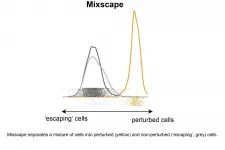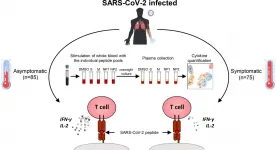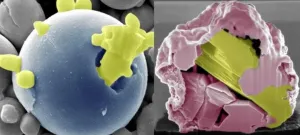(Press-News.org) Because walleyes are a cool-water fish species with a limited temperature tolerance, biologists expected them to act like the proverbial "canary in a coal mine" that would begin to suffer and signal when lakes influenced by climate change start to warm. But in a new study, a team of researchers discovered that it is not that simple.
"After analyzing walleye early-life growth rates in many lakes in the upper Midwest over the last three decades, we determined that water clarity affects how growth rates of walleyes change as lakes start to warm," said Tyler Wagner, Penn State adjunct professor of fisheries ecology. "In some lakes, warming actually led to increased walleye growth rates, in others there essentially was no change, and in others, growth rates declined. The different responses of growth rates to increasing water temperatures across lakes appear to be influenced by water turbidity."
The research is significant, Wagner explained, because walleye fisheries in the upper Midwest are important not just ecologically, but also from an economic and cultural perspective. Because walleye fishing is a valued social activity in Minnesota and Wisconsin and hundreds of thousands of walleye fingerlings are stocked there to bolster wild populations, the region is the ideal place to study the effect of warming conditions on the fish.
According to the U.S. Environmental Protection Agency, the Midwest has gotten warmer, with average annual temperatures increasing over the last several decades. Between 1900 and 2010, the average air temperature increased by more than 1.5 degrees Fahrenheit in the region.
"The rate of increase in air temperature has accelerated in recent decades, and this increase in air temperature will affect the thermal habitat for fishes across the region," Wagner said. "Temperatures are projected to continue increasing across the Midwest -- with the greatest increases in average temperature expected in northern areas -- so we wanted to know what was happening with walleye populations in the upper Midwest."
Using data provided by the Minnesota and Wisconsin departments of Natural Resources, researchers quantified annual walleye early-life growth rates from 1983 to 2015 in 61 lakes in the upper Midwest. Then they estimated the relationship between early-life growth rates and water growing degree days -- an indicator of the temperature the fish are exposed to -- over those 32 years. Importantly, they also examined how water turbidity influenced growth rates across the 61 lakes, correlated to an increased number of growing degree days.
Their findings, published Feb. 23 in the Canadian Journal of Fisheries and Aquatic Sciences, showed that, on average, early-life growth rates increased with increasing growing degree days in turbid lakes, remained more or less unchanged in moderately clear lakes, and decreased in very clear lakes. This suggests that a "one-size-fits-all" approach to managing walleye populations across a broad landscape may not be effective, according to Wagner.
"Rather, lake-specific characteristics likely will be important in determining how walleye populations respond to climate change," he said.
The analysis also indicated that walleye growth rates varied among lakes of different sizes, explained lead researcher Danielle Massie, who graduated from Penn State in 2020 with a master's degree in wildlife and fisheries science.
"Walleye early-life growth rates, on average, were significantly greater in larger lakes," she said. "Our results provide insights into the conservation of cool-water species in a changing environment and identify lake characteristics in which walleye growth may be at least somewhat resilient to climate change."
The results of the research were surprising, Wagner conceded, because researchers expected to see walleye growth rates in most lakes decrease with more growing degree days -- since walleyes prefer cool water. But that did not happen in most of the lakes they studied.
"It sounds counterintuitive at first, but if we think about fish growth, we can think about it as a performance curve, where growth increases with increasing temperature to a certain point," he said. "But as the lake warms past that optimum temperature, the curve descends, and we'll see declining growth as the temperature increases beyond that point."
Slightly higher water temperatures in some upper Midwest lakes have resulted in increased growth rates for walleyes, but if water temperatures continue to rise, influenced by a warming climate, walleye populations in the region will suffer, predicted Wagner, assistant leader of Penn State's Pennsylvania Cooperative Fish and Wildlife Research Unit, housed in the College of Agricultural Sciences.
"We're going to reach a water temperature tipping point where growth will decline, and then we'll see deleterious effects," he said. "This is why understanding what factors, such as turbidity and lake size, influence how fish populations respond to warming is critical for informing management and conservation efforts."
INFORMATION:
Also involved in the research were Gretchen Hansen, Department of Fisheries, Wildlife, and Conservation Biology, University of Minnesota; Yan Li, North Carolina Division of Marine Fisheries, North Carolina Department of Environment Quality; and Greg Sass, Escanaba Lake Research Station, Office of Applied Science, Wisconsin Department of Natural Resources.
The Minnesota Department of Natural Resources, the Wisconsin Department of Natural Resources, the Pennsylvania Sea Grant Program and the U.S. Fish and Wildlife Service supported this research.
The Earth's surface is subject to continual changes that dynamically shape natural landscapes. Global phenomena like climate change play a role, as do short-term, local events of natural or human origin. The 3D Geospatial Data Processing (3DGeo) research group of Heidelberg University has developed a new analysis method to help improve our understanding of processes shaping the Earth's surface like those observed in coastal or high-mountain landscapes. Unlike conventional methods that usually compare two snapshots of the topography, the Heidelberg approach can determine - fully automatically and over long periods - when and where surface alterations occur and which type of associated changes they represent.
The method, known ...
A team of researchers from New York University and the New York Genome Center has developed a new computational tool to help understand the function and regulation of human genes. The results, published today in the journal Nature Genetics, demonstrate how to interpret experiments that combine the use of CRISPR to perturb genes along with multimodal single-cell sequencing technologies.
The article describes how the new approach, called mixscape, helped to identify a new molecular mechanism for the regulation of immune checkpoint proteins that govern the immune system's ability to identify and destroy cancer cells.
"Our approach will help scientists to connect ...
The scientists have demonstrated how to structure light such that its polarization behaves like a collective of spins in a ferromagnet forming half-skyrmion (also known as merons). To achieve this the light was trapped in a thin liquid crystal layer between two nearly perfect mirrors. Skyrmions in general are found, e.g., as elementary excitations of magnetization in a two-dimensional ferromagnet but do not naturally appear in electromagnetic (light) fields.
One of the key concepts in physics, and science overall is the notion of a "field" which can describe the spatial distribution ...
A joint research team co-led by City University of Hong Kong (CityU) has developed a new soft tactile sensor with skin-comparable characteristics. A robotic gripper with the sensor mounted at the fingertip could accomplish challenging tasks such as stably grasping fragile objects and threading a needle. Their research provided new insight into tactile sensor design and could contribute to various applications in the robotics field, such as smart prosthetics and human-robot interaction.
Dr Shen Yajing, Associate Professor at CityU's Department of Biomedical Engineering ...
By analyzing blood samples from individuals infected with SARS-CoV-2, researchers in Singapore have begun to unpack the different responses by the body's T cells that determine whether or not an individual develops COVID-19. The study, published today in the Journal of Experimental Medicine (JEM), suggests that clearing the virus without developing symptoms requires T cells to mount an efficient immune response that produces a careful balance of pro- and anti-inflammatory molecules.
Many people infected with the SARS-CoV-2 virus do not develop any symptoms, and the infection ...
UNIVERSITY PARK, Pa. -- The rate of suicide among post-9/11 military veterans has been rising for nearly a decade. While there are a number of factors associated with suicide, veterans have unique experiences that may contribute to them thinking about killing themselves.
"Compared to their civilian peers, veterans are more likely to report having experienced traumatic adverse childhood experiences (ACEs) such as physical and emotional abuse," stated Keith Aronson, associate director of the Clearinghouse for Military Family Readiness at Penn State and the Social Science Research Institute ...
LAWRENCE -- A new study from University of Kansas journalism & mass communication researchers examines what influences people to be susceptible to false information about health and argues big tech companies have a responsibility to help prevent the spread of misleading and dangerous information.
Researchers shared a fake news story with more than 750 participants that claimed a deficiency of vitamin B17 could cause cancer. Researchers then measured if how the article was presented -- including author credentials, writing style and whether the article was labeled as "suspicious" or "unverified" -- affected how participants perceived its credibility and whether they would adhere to the article's recommendations or share it on social media. The findings showed that ...
AMES, Iowa - Inspired by nature's work to build spiky structures in caves, engineers at Iowa State University have developed technology capable of recovering pure and precious metals from the alloys in our old phones and other electrical waste.
Using controlled applications of oxygen and relatively low temperatures, the engineers say they can dealloy a metal by slowly moving the most reactive components to the surface where they form stalagmite-like spikes of metal oxides.
That leaves the least-reactive components in a purified, liquid core surrounded by brittle metal-oxide spikes "to create a so-called 'ship-in-a-bottle structure,'" said Martin Thuo, the leader of the research project and an associate professor of materials science and ...
A type of ultrasound scan can detect cancer tissue left behind after a brain tumour is removed more sensitively than surgeons, and could improve the outcome from operations, a new study suggests.
The new ultrasound technique, called shear wave elastography, could be used during brain surgery to detect residual cancerous tissue, allowing surgeons to remove as much as possible.
Researchers believe that the new type of scan, which is much faster to carry out and more affordable than 'gold standard' MRI scans, has the potential to reduce a patient's risk of relapse by cutting the chances that a tumour will grow ...
The amount of green space surrounding children's homes could be important for their risk of developing ADHD. This is shown by new research results from iPSYCH.
A team of researchers from Aarhus University has studied how green space around the residence affects the risk of children and adolescents being diagnosed with ADHD. And the researchers find an association.
"Our findings show that children who have been exposed to less green surroundings in their residential area in early childhood, which we define as lasting up until age five, have an increased risk of receiving an ADHD diagnosis when compared to children who have been surrounded by the highest level of green space," says ...




